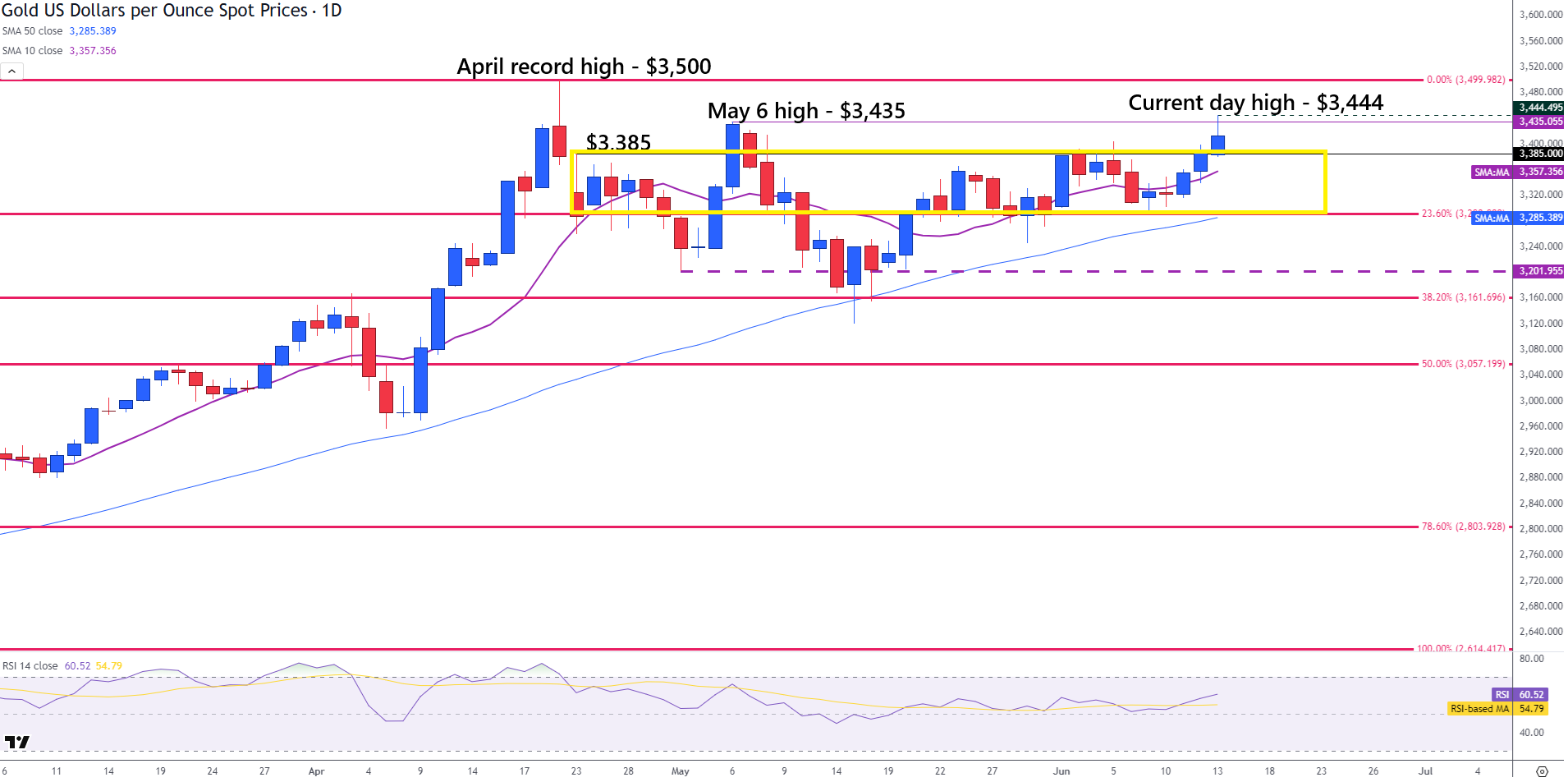Created
: 2025.06.13














![]() 2025.06.13 20:16
2025.06.13 20:16
Gold (XAU/USD) is trading in a strong uptrend after Israel's attack on Iran. The strikes were reported on Friday morning, two days before Iran and the United States (US) were expected to hold the sixth round of talks over Tehran's nuclear program in Oman on Sunday.
At the time of writing, Gold is trading above $3,400 against the US Dollar (USD) on Friday, with markets focused on any further developments in the Middle East, particularly the threats of retaliation from Iran.
On the US economic calendar, market participants will also be looking out for the results from the University of Michigan Consumer Sentiment report and Inflation Expectations, scheduled for release on Friday.
Gold prices are highly sensitive to shifts in consumer sentiment, making this Friday's consumer sentiment release a critical event to watch. As a leading indicator of economic confidence and inflation expectations, the index offers early insight into potential changes in US consumer behavior and pricing pressures.
On Friday, Reuters and Bloomberg reported that Israel had struck multiple facilities in Iran.
Israeli Prime Minister Netanyahu confirmed the attacks, citing that Israel had "struck at the heart of Iran's nuclear enrichment program". Reports from Israel confirmed that roughly 100 targets had been hit using 200 air force planes.
Several senior officials of Iran have been killed, including Hossein Salami, the head of the Islamic Revolutionary Guard Corps, and the military chief of staff, Mohammed Bagheri.
Multiple nations, including Saudi Arabia and China, have condemned the attacks. Chinese foreign ministry spokesperson, Lin Jian, said that "China urges all relevant parties to do more to promote regional peace and stability and to avoid further escalation of the situation. China stands ready to play a constructive role in helping de-escalate the situation."
Gold prices rallied on Friday after reports of the attacks, breaking above the former $3,400 psychological resistance level, which has now turned into support.
The safe-haven appeal of Gold lifted XAU/USD to its second-highest peak this year near $3,444. This level is now providing intermediate resistance for the yellow metal.
Meanwhile, support remains firm at $3,400, with a move lower bringing the $3,385 mark into play. The latter is another crucial level that has limited the upside move in Gold prices on several occasions throughout the week.

Meanwhile, the Relative Strength Index (RSI) stands at 60 and points upwards, indicating a bullish bias. On the downside, the $3,350 psychological level, which has provided support throughout the week, remains intact. Below that is $3,291, the 23.6% Fibonacci retracement of the January-April uptrend.
For bearish momentum to gain traction, a breach of this zone may pave the way for the next big psychological level of $3,200.
In the world of financial jargon the two widely used terms "risk-on" and "risk off'' refer to the level of risk that investors are willing to stomach during the period referenced. In a "risk-on" market, investors are optimistic about the future and more willing to buy risky assets. In a "risk-off" market investors start to 'play it safe' because they are worried about the future, and therefore buy less risky assets that are more certain of bringing a return, even if it is relatively modest.
Typically, during periods of "risk-on", stock markets will rise, most commodities - except Gold - will also gain in value, since they benefit from a positive growth outlook. The currencies of nations that are heavy commodity exporters strengthen because of increased demand, and Cryptocurrencies rise. In a "risk-off" market, Bonds go up - especially major government Bonds - Gold shines, and safe-haven currencies such as the Japanese Yen, Swiss Franc and US Dollar all benefit.
The Australian Dollar (AUD), the Canadian Dollar (CAD), the New Zealand Dollar (NZD) and minor FX like the Ruble (RUB) and the South African Rand (ZAR), all tend to rise in markets that are "risk-on". This is because the economies of these currencies are heavily reliant on commodity exports for growth, and commodities tend to rise in price during risk-on periods. This is because investors foresee greater demand for raw materials in the future due to heightened economic activity.
The major currencies that tend to rise during periods of "risk-off" are the US Dollar (USD), the Japanese Yen (JPY) and the Swiss Franc (CHF). The US Dollar, because it is the world's reserve currency, and because in times of crisis investors buy US government debt, which is seen as safe because the largest economy in the world is unlikely to default. The Yen, from increased demand for Japanese government bonds, because a high proportion are held by domestic investors who are unlikely to dump them - even in a crisis. The Swiss Franc, because strict Swiss banking laws offer investors enhanced capital protection.
![]()
Created
: 2025.06.13
![]()
Last updated
: 2025.06.13

FXStreet is a forex information website, delivering market analysis and news articles 24/7.
It features a number of articles contributed by well-known analysts, in addition to the ones by its editorial team.
Founded in 2000 by Francesc Riverola, a Spanish economist, it has grown to become a world-renowned information website.
We hope you find this article useful. Any comments or suggestions will be greatly appreciated.
We are also looking for writers with extensive experience in forex and crypto to join us.
please contact us at [email protected].
Disclaimer:
All information and content provided on this website is provided for informational purposes only and is not intended to solicit any investment. Although all efforts are made in order to ensure that the information is correct, no guarantee is provided for the accuracy of any content on this website. Any decision made shall be the responsibility of the investor and Myforex does not take any responsibility whatsoever regarding the use of any information provided herein.
The content provided on this website belongs to Myforex and, where stated, the relevant licensors. All rights are reserved by Myforex and the relevant licensors, and no content of this website, whether in full or in part, shall be copied or displayed elsewhere without the explicit written permission of the relevant copyright holder. If you wish to use any part of the content provided on this website, please ensure that you contact Myforex.
Myforex uses cookies to improve the convenience and functionality of this website. This website may include cookies not only by us but also by third parties (advertisers, log analysts, etc.) for the purpose of tracking the activities of users. Cookie policy